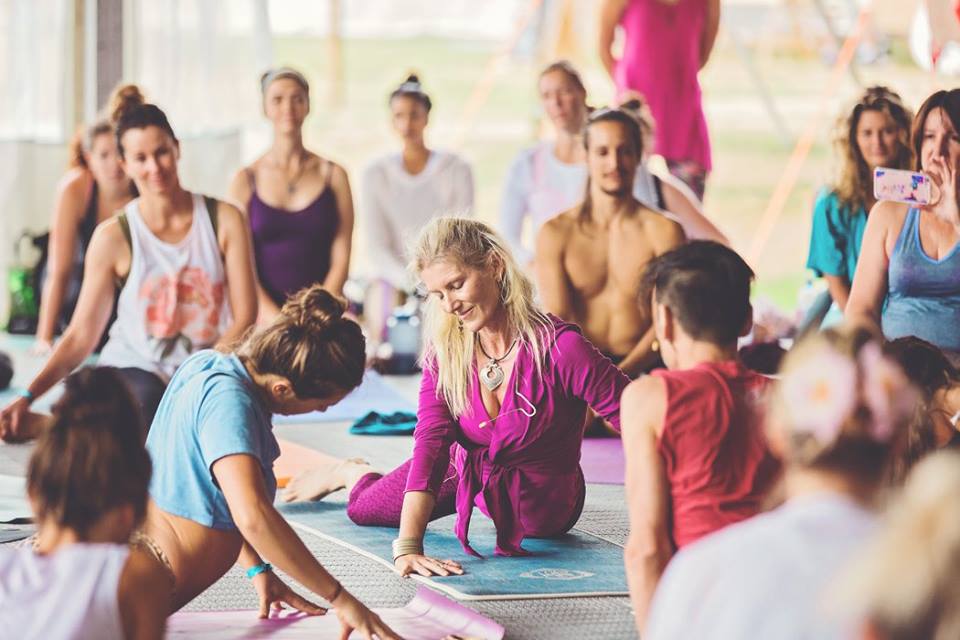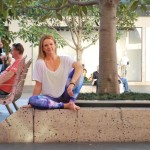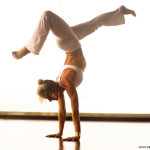 Is it time to juice up your yoga teaching cues? Take inspiration from Shiva Rea, shown here at Wanderlust Great Lake Taupo. Photo Credit: June Bug Photography
Is it time to juice up your yoga teaching cues? Take inspiration from Shiva Rea, shown here at Wanderlust Great Lake Taupo. Photo Credit: June Bug PhotographyBy Michelle Jayne, Yoga facilitator, therapist & coach
“Step your foot forward and stretch your arms up.”
I looked around the studio I was practicing in, trying to figure out if we were still on the right leg, or without warning, this had changed.
“Square your hips forward, breath in, stretch your arms, breath in, bend your front knee, and take one more breath.”
Hang on a second, I hadn’t had a chance to breath out, and if I continued listening to the teachers cueing, I was about to faint for lack of oxygen.
Unfortunately the above experience is not unusual.
In a survey completed by the School of Complementary Medicine at RMIT, asana and vinyasa practice (postures and sequences of postures) were found to represent 61% of time spent practicing yoga.
If this is the case, and the necessary tools for a yoga teacher is verbal communication, then that leads a lot of people who practice the physical aspect of yoga down a very shaky, clumsily led path.
Language is an art form of itself, and yoga is a healing art.
The importance of being able to reach students beyond the mere physical experience relies heavily on our ability to utilize diversity of language, similes and metaphors, and to create a rich tapestry, that weaves our intentions for our classes effortlessly into the students practice whilst under our guide.
The understanding of the mechanics of the body is of utmost importance to keep our students safe; the creation of sequencing including breath, asana, mantra and many other elements can be tricky to squeeze into a one-hour class.
Then there is the challenge of being able to hold space in a room of various abilities, whilst effortlessly guiding all sorts of adjustments to suit the multiplicity of levels in the room.
Our ability to teach magnetically and creatively ensures that we begin to create a conversation with the students in the room rather then just directing their body parts and telling them what to do.
The trick to teaching anything, whether it be yoga or cooking, is the ability to get the students into an environment where they are open to learning.
Yoga is an exploration within self, and the way you lead this journey can either bring people closer to inner connection or further away.
So, what would be some ways in which you could enrich your classes with the use of language?
1. Theme Your Class
This is probably the most important one. Without having some sense of container for what it is you are trying to accomplish within the class, it is highly likely that you will jump from one thing to the other, creating havoc, and generally leaving a sense of confusion for your students.
Picking a theme doesn’t have to be extravagant. You could tap into the seasons, astrology, chakras, meridians, a poem, a quote, one of the sutras – it could be one thing that gives you a sense of direction. Once you have your theme, you are then able to work your language around this theme.
2. Diversity of Language
Maya Angelou said people will forget what you said, people will forget what you did, but people will never forget how you made them feel.
Remember, yoga is a healing art, not just an exercise routine. So embellish the language a little. Head to your nearest Thesaurus and start by looking up how many different words there are for breathe, stretch, lift and turn, just to name a few.
Your ability to say the exact same thing in a variety of different ways will keep your students engaged and interested. The power of our ‘feeling’ cues dives students deep into the experience of what is happening from the inside out, rather then the outside in. This means you will need to get in amongst your students, be in the experience unfolding and be mindful of…
3. Disempowering language
This can be a tricky one. Sometimes it feels useful to have an open-to-interpretation comment thrown out there. The only problem is, the habit detracts from clarity, intention and strength of our teaching instruction.
Some examples of disempowering instructions include:
- Sort of squeeze the left butt cheek
- Kind of relax the shoulders
- What I’d like you to do is step forward into Down dog
- When ever you’re ready come up from Child’s pose
Better to be clear and directive in class than wishy-washy. You’re either doing something, or you’re not.
4. Filler Words
Ahh, those comfortable little utterances that are muttered when we lose track of what we are saying, don’t know what we are saying, freak out because it’s too quiet, love the sound of our own voice, think the students enjoy our endless dialogue about how much we know about what we are teaching and so on.
If any of these sound familiar, then it’s time to do a spring clean of your verbal environment:
- So from here let’s move into Warrior 1
- And then sink the sit bones deep towards your heels
- Anyway, take a deep inhale, and jump to the top of your mat
- All right step back into plank
- Just hold here for two more breaths
- Now you’re gonna press firmly through your feet
- Go ahead and stretch the right leg up into three legged dog
Now, re-read those statements and ditch the filler words – “so”, “and then”, “anyway”, “all right”, “just”, “now you’re gonna” and “go ahead”. They’re not needed and you’re cueing is stronger without them.
Teaching can be full of lively insight, experience, and nuances – it’s not just a bone-dry recitation of information.
Use language that appeals to sensations and feelings. We owe it to our students to continually refine our language and make changes when our language is muddled, ineffective or unclear.
About Michelle
 Michelle is a Yoga Teacher/Therapist/Mentor with over fifteen years experience in the holistic field. Her passion is in teaching with authenticity to inspire those to dive deep into the resources of themselves, understanding always that it is within each of us to call forward the motivation and possibilities that reside within.
Michelle is a Yoga Teacher/Therapist/Mentor with over fifteen years experience in the holistic field. Her passion is in teaching with authenticity to inspire those to dive deep into the resources of themselves, understanding always that it is within each of us to call forward the motivation and possibilities that reside within.

@Admin
Hi
How do you change pose in yoga? While inhaling, exhaling or holding air?
Regards
Anjali
Hi Anjali
There are many ways to experiment with the breath in our practice. Traditionally in a Vinyasa style practice, the inhale occurs on an expanding pose, example from Downdog stepping forward to lunge pose would be an inhale, while exhale occurs more on the contracting or compression part of the posture, so from lunge, stepping in forward fold and exhale.
Try a basic Sun Salutation and as you take a breath with each movement, feel in your body how the breath matches to the shape in the body.
Let me know if you have any further questions
Thanks for reading
Michelle Jayne
How do you change pose in yoga? While inhaling?